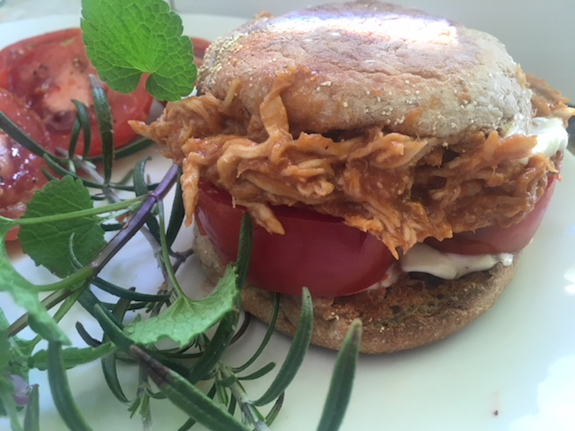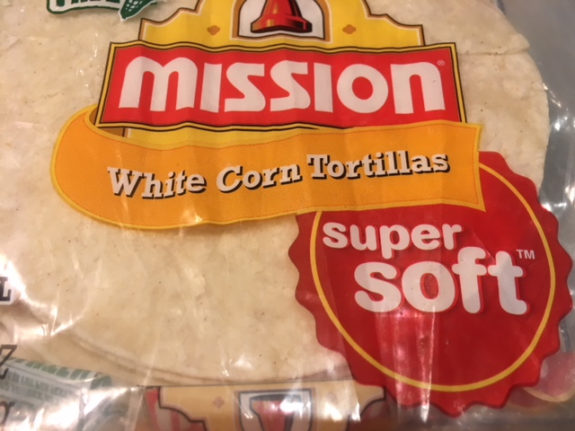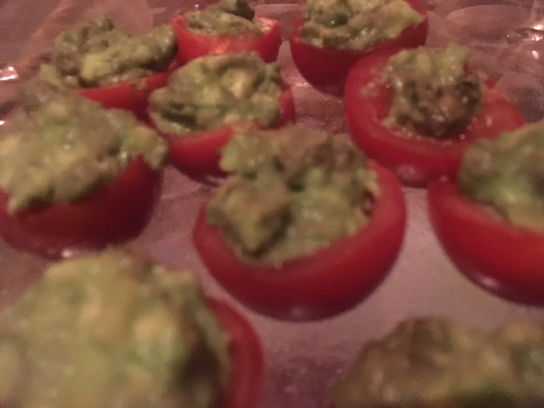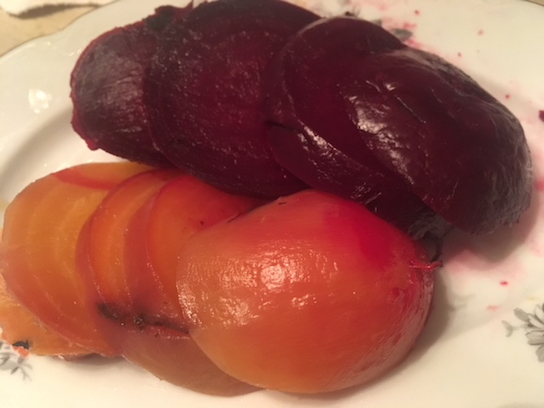Processed Food? You’d Be Surprised How Delish!
While making meals from scratch has been the paragon of nutritional virtue, it is increasingly unrealistic for most people in our crazy busy lives to even contemplate. And while processed, pre-prepared, packaged, frozen, vacuum packed, and even canned options seem like an abomination to many of you, they can be more nutritious – and many times quite yummy – for a fraction of the cost of a restaurant meal.
I’ve always enjoyed BBQ, but have never quite gotten the hang of making a really delicious one. The best BBQ I’ve ever had was in Texas – and it took days to make! BBQ in restaurants I’ve found too greasy, filling, and expensive. But I recently discovered a pre-packaged one in a local grocery store’s refrigerator section that is mouthwatering. For only 200 calories in a 1/2 cup serving – it is perfect for me (and, of course, most men could have twice that much). Try it yourself!
No Time to Cook? No Problem!
- At February 04, 2018
- By Katherine
- In News, Recipes
 0
0
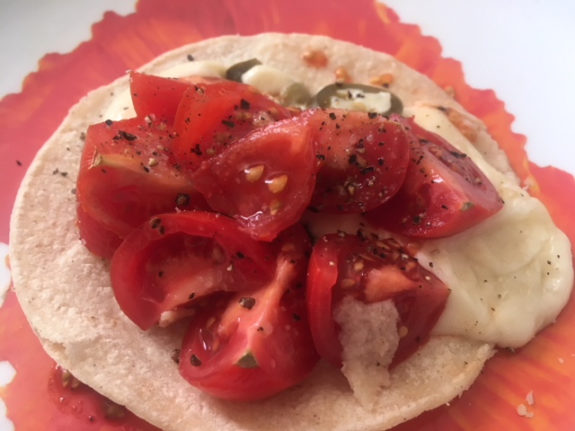
Katherine’s Quick and Easy Soft or Fried Tacos with Light Cheese and Chopped Tomatoes, Onions and Jalapeno Peppers
No one wants to cook anymore. Who can blame them? We’re all so busy. When you get home from work, you’re exhausted, right? Simply too tired to cook a meal, or not willing to use up valuable relaxation time for cooking. No longer do we have the luxury of stay-at-home moms or dads who slave over a properly balanced home cooked meal every day. Personally, I spent so many years developing and testing recipes for my books, I’m sick of cooking myself. So I devote a lot of my “recipe” development time these days looking for recipes that don’t need a recipe… you know, meals whipped up in minutes without any rules.
The biggest challenge for most people is after-work dinners. But I’ve found many good solutions for creating easy, tasty and quick meals. Some take literally five minutes.
One of my favorites is an open-faced taco. I buy small, thin, whole corn tortillas and make either a soft or a fried version. But the ingredients are the same. Tomatoes are notoriously bad this time of year, but I find the smaller tomatoes on a vine excellent. I keep them on the counter for days – even weeks – and their flavor concentrates.
Katherine’s Quick and Easy Soft or Fried Tacos with Cheese, Chopped Tomatoes, Onions and Jalapeno Peppers
other toppings include avocado, fish, shrimp, chicken chunks, you name it!
1 serving:
Medium sized plate
2 Taco shells
2 Bonbel light cheese rounds
Canned Jalapeno pepper slices, to taste
Chopped FreshTomatoes, to taste
Chopped Fresh Sweet Onions, to taste
Chopped Fresh Celery (optional)
Chopped Fresh Avocado (optional)
Flaky White Fish Filet (optional)
Chopped Fresh Cilantro (optional)
Salt and Freshly Ground Pepper
Place the 2 tacos on the plate, top with the cheese and jalapeno pepper slices. Microwave for about a minute, until the cheese has melted. Pile on the remaining veggies, cilantro, salt, pepper, and any other toppings you’ve chosen. Roll up and eat!
For the fried version, I add a little canola or olive oil to a non-stick pan. When hot, I put the tacos in and brown on one side. Flip over and top with the cheese, veggies and other toppings. Once the cheese melts, they’re ready to eat.
I buy the thinnest corn tortillas I can find. At only 50 calories each, and with mainly veggies, you have a spicy, filling low-calorie meal – perfectly balanced – that everyone loves. For the guys who need more – eat more! It’s just more nutrition! To add more calories, pile on the cheese.
Other toppings can be fish, shrimp, chopped chicken, avocado… really, anything you like. I’ve discovered a spicy frozen fish filet that’s ready in minutes that I think works perfectly.
Light and Creamy Mashed Potatoes for the Thanksgiving Table
- At November 23, 2017
- By Katherine
- In News, Recipes
 0
0
Marion Burros’ Streamlined Mashed Potatoes
(Excerpted from “Diet Simple: 195 Mental Tricks, Substitutions, Habits & Inspirations”)
Potatoes have more potassium than any raw fruit or vegetable, even a banana. Potatoes contain half your requirement for Vitamin C. They rank 5th out of 42 vegetables tested for antioxidant capacity, coming ahead of broccoli, cabbage, and tomatoes. A 5.3 ounce serving of potatoes have only 110 calories. Potatoes could sustain your body healthfully with just a few dairy products and oil added. Think of all the cultures through hundreds, and thousands of years, which survived on potatoes… Scandinavians, Russians, Irish, Peruvians… You get the picture!
I can’t imagine a better comfort food!
Serves 6
1 pounds unpeeled thin-skinned potatoes (Yukon Gold or other boiling potatoes), scrubbed and sliced 1/4 inch thick
2 Cups Nonfat Buttermilk, or more
Salt and freshly ground black pepper to taste
Garnish with chopped parsley (optional)
1. Cook the potato slices in water to cover until tender, about 10 minutes. Do not let them get so soft that they start to disintegrate; that makes them watery. Drain and mash the potatoes – peel and all – in a food mill, through a ricer, or with a potato masher.
2. Stir in the buttermilk until the potatoes become creamy. Season with salt and pepper. Add chopped parsley to taste (optional)
NOTE: The potatoes can be refrigerated, if well covered, but they are best when fresh. To serve, place in a glass dish, cover wtih plastic wrap, and reheat in the microwave for about 8 minutes on high. Stir once or twice while reheating. If the potatoes become too dry, stir in additional buttermilk. Use waxy potatoes for boiling like Red Bliss or fingerlings. Yukon Golds are all-purpose.
Streamlined Mashed Potatoes is excerpted from Cooking for Comfort (Simon & Schuster 2003) by Marion Burros. Burros is a columnist and writer for The New York Times since 1981, she lives in New York City and outside Washington, D.C.
A Fall Menu for Guests with Dietary Food Restrictions
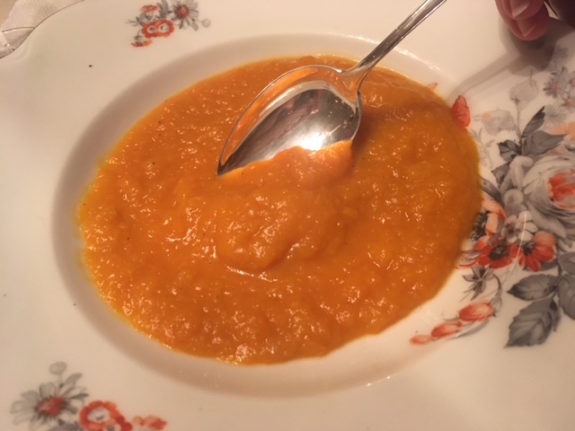
Butternut Squash Soup with Curry and Ginger – from “Diet Simple Farm to Table Recipes: 50 New Reasons to Cook in Season!” (squash, onions and ginger from Farmers Market)
Cooking for special guests with food restrictions can seem an ominous task. It often means that none of your favorite special occasion recipes work, risking disappointing your guests with a less than delcious meal.
I was recently faced with entertaining a friend who couldn’t eat grains, starch, sugar, dairy, eggs, legumes, peanuts, almonds, garlic, or alcohol … You get the picture! But my friends said I did it well, so I thought I would share my menu with you.
First, since my food choices were limited, the recipes were likely going to be fairly simple. so choosing the best ingredients was paramount. Obviously, that meant I bought just about everything from the local Farmers Market.
As Hors d’oevres, I served Guacamole Stuffed Cherry Tomato Halves. On most diets, vegetables are unlimited, so you can’t go wrong with them. My quacamole was simply mashed avocado with salt and pepper. You can stuff the cherry tomato halves with anything – tuna or smoked salmon salad, tabouleh, etc. I also served pistachio nuts in a side dish (always with a spoon to prevent spreading germs).
As the first course, I served Butternut Squash Soup with Curry and Ginger, always a hit. I created this recipe years ago, because I couldn’t find a butternut squash soup recipe with no cream. Of course, this made it perfect for this special menu. All I had to do was to excluded the garlic.
As the main course, I served a crab cake, topped with a tiger shrimp and 2 scallops as decoration. All bought that day from Stachowski’s in Georgetown. The guests were overwhelmed with the freshness, sweetness and delicacy of the seafood. And I confirmed that nothing in the crabcake was verboten. With most of these diets, protein is not limited, but I chose seafood to be on the healthier side. My side dishes were Haricot Vert sauteed in olive oil with sweet onions and red peppers.
And for color, golden and red beets simply boiled with salt and sliced, were served alongside.
Of course, I really wanted dessert to be special. But I was limited to fruit. Hmmm… I’ve eaten roasted fruit, like apricots and peaches, and sauteed fruit in butter and brown sugar. The butter and brown sugar were out, so I decided to roast fruit, which I had never done before. I looked up a few recipes, found fresh pineapple and fresh figs at the grocery store and thought long and hard about what I could roast them in. Could they be roasted alone? I couldn’t find any recipe this simple and I was afraid to try it. It seemed that the fruit would need some kind of fat and sweetener to make it special. But I couldn’t use butter or sugar. Instead, I chose coconut milk, hazelnut oil, and a little honey. I tossed the fresh pineapple pieces and fig halves, in a bowl with the mixture, added pecans, and placed them on a cookie sheet with parchment paper (nothing sticks to it). Roasted til the pineapple was golden brown.
But that wasn’t enough. I needed something creamy with it… ice cream or whipped cream were out of the question. But I heard that coconut milk was popular with the alternative dieting crowd (even though it riases bad cholesterol more than anything else!), so I looked up how to make something creamy out of it. Turns out, it gets nice and fluffy when whipped with a beater. I served it alongside the fruit. And it was a hit!
With a willingness to experiment, try new recipes, and to please your friends who want to eat great food but may be on special diets, it’s worth it to take your cooking into a new direction. My dinner was probably hit and miss. But my friends appreciated my effort and I’m sure enjoyed at least most of it!
Baked Apples with Roasted Nuts and Dried Fruit
- At November 12, 2017
- By Katherine
- In News, Recipes
 0
0
The most popular fruit in the United States, apples are a great source of fiber and vitamin C. Apples also contain quercetin, a compound that may help prevent cancer and heart disease, also xeaxanthin, important for eye health. Be sure to eat the peel. The majority of nutrients are in the skin. At the market, choose firm apples with no soft spots or bruises. Be sure to wash apples under clean, running water before eating. (excerpted from the “Fruit and Veggie Glossary” in Diet Simple Farm to Table Recipes: 50 New Reasons to Cook in Season!)
Apples and their pear cousins are the only locally grown fruit from now until… May or June! But don’t despair. Apples are a versatile fruit, come in many shapes, sizes, colors, flavors and textures. They can be eaten “as is” or incorporated into sweet or savory recipes. Think waldorf salad, apple crisp, apple cakes, caramel apples, hard or soft apple cider, Thanksgiving stuffing, German potato salad, applesauce, poached apples in wine sauce. Grate apples into your pancakes, coleslaw, muffins, and loafs. Chop apples and toss them in your tuna or chicken salad. Use apples any time you want an alternative color, texture or flavor in a recipe or menu. You get the idea! My Baked Apples can be eaten as a dessert, a snack, an appetizer, a first course or a satisfying end-of-day refreshment with tea.
Katherine’s Baked Apples with Roasted Nuts & Dried Fruit
excerpted from “Diet Simple: 195 Mental Tricks, Substitutions, Habits & Inspirations”
A traditional yet simple and healthy dessert.
4 servings
4 large apples
1 C water, sweet white wine or apple juice
8 tsp sugar, brown sugar or maple syrup
1 tsp cinnamon mixed into the sugar (optional)
1/2 C chopped nuts or dried fruit (optional)
Peel the top half of the apples and, using a apple corer or melon baller, core the apples. Put about 1” of the water in a baking pan. Place the apples in the pan, blossom end down. Sprinkle about 1 tsp of the sugar in the cavity of the apple and 1 tsp around the top. If desired, stuff chopped nuts and/or dried fruit into the cavity.
Bake uncovered for about an hour, or until apples are very tender. Cool and serve warm or at room temperature, or refrigerate. Serve with sweet or sour cream or nonfat Greek yogurt.
Only about 90 calories each!
10 Tips for Enjoying Halloween Candy Without Guilt or Consequences
- At November 01, 2017
- By Katherine
- In News, Recipes
 0
0
Now that you have all that Halloween candy, what is a healthy way to handle it, especially for your children? You don’t need to think of candy as “bad.” Studies over the years have found there is no association between candy eating and poor health or weight gain. But eating candy in moderation helps.
There are a few simple strategies designed by behavioral scientists and nutritionists to help your children (or you) enjoy candy without guilt or even weight gain. Remember:
1. Moderation is more realistic than complete elimination,
2. Eat about 10% of your daily calorie needs as candy and you can still maintain a healthy body and weight (most women consume about 1800 calories/day, so their candy allottment might be 180 calories daily. For men, perhaps about 220 calories),
3. When candy is in the house, it’s fair game for everyone. Denying access to candy your child knows is in the house (and they always know!) is counterproductive and can eventually lead to bingeing when it becomes available,
4. Remove the emphasis on restriction. If you don’t want someone in your house eating candy, don’t have it in the house. This changes the emphasis from what you “can’t” have, to what you “can” have,
5. Structure your family’s eating. Eat regularly scheduled meals at predictable times through the day,
6. Provide reasonable guildelines for eating the candy that is in the house, and practice what you preach,
7. If you’d like your child to eat candy moderately, limit how often it is brought into the home and serve small portions, or use pre-packaged candy in small amounts,
8. Serve all food positively. Fruits, vegetables and other wholesome foods should be presented just as positively as candy,
9. Don’t use candy as a reward of any kind,
10. Above all else, provide a consistently positive atmosphere in which all food is eaten. There is no “good” or “bad” food. All food fits, but you may need to define the balance, amounts, and timing that candy or any food is eaten in the household.
Nora Pouillon’s Classic Ratatouille
- At October 22, 2017
- By Katherine
- In News, Recipes
 0
0
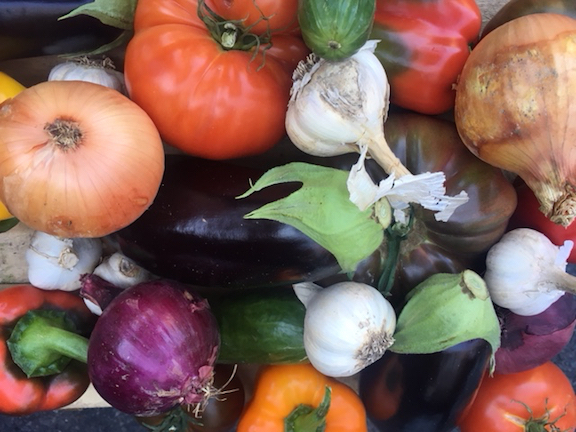
Vegetables for Nora’s Ratatouille were all Found at Twin Springs Fruit Farm Stand from Ortanna, PA (90 Miles from DC)
Nora Pouillon’s Ratatouille
Adapted from
“Cooking with Nora”
And Excerpted from “Diet Simple”
Ratatouille is an authentic aromatic Provençal ragout of onions, eggplants, peppers, zucchini, and tomatoes, stewed slowly in olive oil and flavored with garlic and fresh herbs. At the Dupont Circle Fresh Farm Market, I recently found every vegetable and herb needed for this amazingly tasty and versatile dish – all from Twin Springs Fruit Farm in Ortanna, Pennsylvania. The farmers travel 90 miles to provide us city folks with the freshest, juiciest, most delicate fruits and vegetables to be had – not to mention the extraordinary nutrition they provide!
Cutting up the vegetables is time consuming and that is why I like to make double or more than the amount I need and use the leftovers …
• at room temperature the next day with grilled chicken or fish.
• mixed with eggs and cheese for a Quiche Provencal.
• heated up and stirred with beaten eggs, spiced with chilis and served with sliced ham, Prosciutto, or cooked lean sausage as Piperade or Basque dish.
• reheated and used as sauce for freshly cooked pasta, garnished with feta or goat cheese, with the addition of pitted black olives if desired.
• As Minestrone, heated with vegetable or chicken stock, adding a can of drained cannellini beans and maybe a spoon of pesto on top.
The trick of a good ratatouille is not to overcook the vegetables. They have to be added one after the other, depending on the amount of time they need to cook to be just tender. Of course, Nora recommends all the vegetables be organic.
6 – 8 servings
1/2 cup olive oil
1 large onion, chopped
1 Tablespoons garlic, minced
1-2 eggplants (2 lbs) cut into 1-inch cubes
2 peppers, red, green or yellow, cut into 1-inch squares
2 zucchini (1.5 lbs) cut into 1-inch cubes
1.5 lbs tomatoes, peeled and cut into 1-inch cubes
salt and freshly ground black pepper
1 Tablespoon thyme, minced
1/2 Tablespoon rosemary, minced
2 Tablespoon parsley or basil, minced
Heat the olive oil in a large skillet until hot.
Add the onions and stew for 10 minutes until soft. Add the garlic, then the eggplants and peppers, cover and cook slowly for 20 minutes.
Add the zucchini, cook for 5 minutes, then lastly add the tomatoes and cook for an additional 5 minutes or less.
Season with salt and pepper and the minced herbs.
Calories 220 Percent of Daily Value
Calories from Fat 150
Total Fat 16g 25%
Saturated Fat 2g 11%
Cholesterol 0mg 0%
Sodium 15mg 1%
Total Carbohydrate 18g 6%
Dietary Fiber 6g 22%
Soluble Fiber 1.13 g
Omega 3 Fatty Acids 0.14 g
Sugars 10g
Protein 3g
Vitamin A 60%
Vitamin C 160%
Calcium 4%
Iron 8%
A Natural Remedy for Coughing
- At September 26, 2017
- By Katherine
- In News, Recipes
 0
0
I don’t know about you, but I’ve noticed a lot of sniffles and coughing going on this season (and unfortunately, that includes me!). Whether it’s from an allergy, a cold, an upper respiratory tract infection, post nasal drip, or gastroesophageal reflux disease (GERD), there’s an age-old remedy for coughing that has been recently proven by science to be effective. The ingredient is easily available, and is often a staple in your own kitchen.
What is it? Honey. “An 8,000 year old cave painting in Spain depicts honey harvesting, and we know it’s been used for food, medicine, and more by cultures all over the world since,” according to Ullman’s Encyclopedia of Industrial Chemistry.
“Coughing is a protective reflex action triggered by irritation or obstruction of the airwaves,” according to this study in Pediatric Reports. “There is a high prevalance in children and it impacts a child’s ability to sleep, play and eat. It is the largest single cause of primary care doctor visits.”
Honey was found to be more effective than dextromethorphan, found in common over-the-counter cough medicines, according to this study reported in Archives of Pediatric Adolescent Medicine. In fact, these results found the medicine was no better than the placebo.
In another study, coughing was reduced and sleep was improved in 2-year-olds with upper respiratory tract infections when they were given 2 teaspoons of honey before bedtime. In the study, honey was as effective as dextromethorphan, according to the Mayo Clinic.
A similar conclusion was found in a review of studies published in Cochrane Database Systematic Reviews, when children aged 1 to 18 were tested.
The World Health Organization identifies honey as a potential treatment for cough.
Honey is an especially good potential remedy for children, as it could be a natural way to avoid overuse of drugs like antibiotics (but check with your doctor first!).
Honey Cough Syrup
1-1/2 Tablespoons Zest of 2 Lemons
1/4 Cup Peeled, Sliced Ginger or 1/2 teaspoon of Ground Ginger
1 Cup Water
1 Cup Honey
1/2 Cup Lemon Juice
In a small saucepan combine lemon zest, sliced ginger ad 1 cup of water. Bring mixture to a boil and simmer for 5 minutes. Then strain into a heat-proof measuring cup. Rinse the saucep and and pour in 1 cup of honey. On low heat, warm the honey but don’t allow it to boil. Add the strained lemon ginger water and the lemon juice. Stir the mixture until it combines to form a thick syrup. Pour into a clean jar with a lid. This can be refrigerated for up to 2 months.
* Recipe by the National Honey Board
The Perfect Labor Day Recipe: Katherine’s Salsa Fresca with Watermelon
- At September 01, 2017
- By Katherine
- In News, Recipes
 0
0
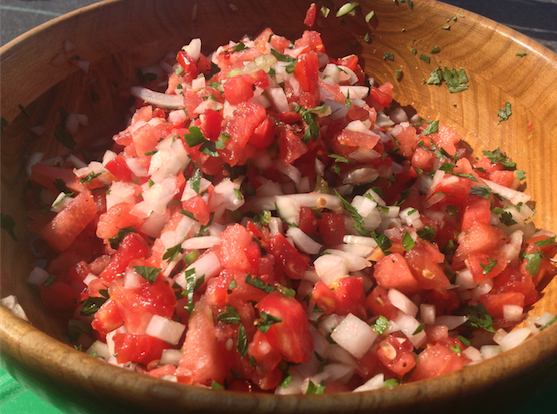
Katherine’s Spicy Salsa Fresca with Watermelon from “Diet Simple Farm to Table Recipes: 50 New Reasons to Cook in Seasons!”
Katherine’s Spicy Fresh Salsa with Watermelon
www.KatherineTallmadge.com
excerpted from “Diet Simple Farm to Table Recipes: 50 New Reasons to Cook in Season!” ($4.95)
Nothing could be a more perfect Labor Day recipe. Featuring the best fruit of the season! It contains all the flavors: sweet, savory, spicy, and salty. I usually use vine-ripe tomatoes for my fresh salsa, excerpted from my book, Diet Simple. But watermelon is a surprising and exotically delicious substitute for all the tomatoes, or just half of them – as in this version. Serve this salsa with grilled salmon, chicken or beef… even tortilla chips… whatever you may traditionally use salsa with.
22 servings
Ingredients:
1 lb vine-ripe, fresh tomatoes, coarsely chopped (start with about 1-1/2 lbs)
1 lb chopped watermelon, seeds removed
1 large candy onion, peeled and chopped (about ½ pound)
3 – 4 jalapeno peppers (1 – 2 ounces), to taste
¼ cup chopped fresh cilantro
½ tsp salt, or to taste
freshly ground pepper, to taste
3 – 4 Tbsp fresh lime juice (1 – 2 limes), optional, or vinegar if you wish for the salsa to last longer in your refrigerator
Add the onion to the tomatoes and watermelon. Finely chop 2 of the jalapeno peppers to start with. Taste. If you desire more heat, add 1 – 2 more jalapenos. Mix in the cilantro. Add the salt and pepper, depending on your taste. Mix in the lime juice, if you wish.
Afternoon Delight! Swedish Waffles, Vanilla Bean Yogurt and Fresh Summertime Peaches
- At August 11, 2017
- By Katherine
- In News, Recipes
 0
0
When I was growing up, my Swedish mother would make crepes for dinner when my father was away traveling. She’d indulge us (and herself) with some of her simple and delicious treats, one of which was crepes, topped with butter, confectioners’ powdered sugar, whipping cream, and lingonberries (a berry similar to a cranberry but sweeter and smaller). Actually, it was more like a dessert for dinner! Those were the days…
Today, I use this recipe using skim or 1% milk, and the crepe-thin, crispy, eggy waffles are topped with vanilla bean greek yogurt and fresh fruit – whatever’s in season. This spring, it was local Farmers Market strawberries. This time of year, sweet and juicy peaches. Yummy!
I’ve been treating my friends to waffle parties recently. Sometimes they’re a treat for breakfast, sometimes lunch, and sometimes dessert, topped with gelato… They’re loving it! So am I…

